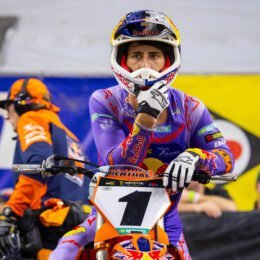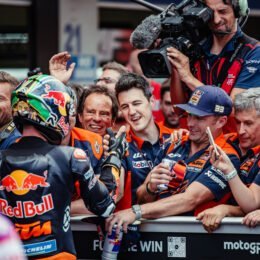THE MOTOGP™ CONTRACT MOVER
Jens Hainbach, Vice President Sports Management Road Racing, has a rewarding but delicate job as one of the main chess piece movers for the company and its multi-classes participation in MotoGP™. Seven years into the role, the 50-year-old tells us about the maturing talent scheme where the KTM roster is now bursting with potential.

PC @Polarity Photo
‘Silly season’ – the period in the racing calendar where riders and teams decide their changes and futures – is always one of the most speculative and fascinating parts of the motorsport year. The fans revel in the gossip and the possibilities of new faces on new bikes and how those racers and rising stars will fare.
Usually, the bigger the name, the earlier a long-term contract is sorted. But there are also unexpected twists in the paddock landscape that get the tongues wagging (and journalist’s keyboards bouncing). A former racer like Hainbach is at the centre of this complicated weave of negotiations and discussions that not only include where a rider is employed but also which team receives factory support, the color of the bike and the short, mid and long-term prospects of projects and investments. He helps bring together the key management figures that take decisions and write the checks to keep the Pierer Mobility Group’s Grand Prix racing efforts (as well as development series’ like FIM JuniorGP, Red Bull MotoGP Rookies Cup and the Northern Talent Cup) ticking over and heading towards their objectives.

PC @Polarity Photo
In 2023 so far Hainbach is having some interesting talks. Talent like Daniel Holgado, Deniz Öncü and Jose Rueda are shining in Moto3™, and former Moto3 world champion Pedro Acosta is making big strides in Moto2™ (and he has been heavily linked to one of the company’s berths in MotoGP where KTM have already watched Brad Binder and Jack Miller take podium finishes). Then there are other considerations, such as the clamour to elevate Jake Dixon from his Moto2 berth to the premier class to give the UK some much needed representation on the grid.
It feels like there are a lot of balls to juggle, and that’s without appreciating how advanced and competitive the RC16 looks to be this season and the appeal of racing MotoGP for KTM. This wasn’t always the case. To get an orientation on both his tasks and the current demands of his work, we pestered the friendly German for some of our own face time…
Jens, how has the job changed in the last five years?
It’s changed quite a bit because we decided that it would be nice and beneficial to have one Pierer Mobility Group representative in the paddock all the time. So, I took the role, meaning quite a lot of travelling and less days in the office but it’s fine for me and it makes sense for all the topics that come up in any of the classes or with IRTA or Dorna. I’m more in my office at the circuit than I am in Austria! The technical side and the management side have a good split. Everybody knows their job and their place and we come together to try and make the best of what we have.
The size of the company’s ‘footprint’ in MotoGP hasn’t expanded that much, right?
It changed a bit in Moto2 with the involvement of other brands. The teams that were already connected to us took on a bit more and it also took a bit more time for us to get them sorted with everything they needed.
How tricky is it to organize the pathway of the rising generation of talent, and then deal with the stars compared to the rising stars…?
Very tricky, and that is why we really need the help and input of team managers like Aki [Ajo], Hervé [Poncharal], and others to take a decision and follow these young guys, identify their strengths and weaknesses, and see what we can do to help them improve and ‘grow up’ to potentially be ready for the challenge of MotoGP. You never really know how a young rider will develop. There is always a bit of a ‘guessing game’ to support the right one. Sometimes it will work, sometimes it doesn’t. There is also this issue of ‘lack of space’ when you get to the top, which means the decision on the rider that gets the vote is critical. It’s always a bit of a bet.

PC @Polarity Photo
There must be some hard decisions along the way because riders mature and progress at different times. They cannot all be teenage hotshots like Pedro Acosta…
Yes, because you have different levels of ability, different characters, different backgrounds. Some riders you enjoy working with, but you see that they are not reaching a certain level of ability. It means some hard decisions that you don’t want to take but, in the end, it is all about performance. That’s what makes the job quite easy because we’re rated by what we achieve on a Sunday afternoon and it’s what we have to look for. We make sure we have as much information as possible before we make a decision. It is not only about what the riders are doing on the track but what they are doing off the track, their surroundings, their entourage and how they behave and how they support the rider. There are many things. It’s the same with a bike; it’s not only the engine or the chassis or the aero, it’s the whole package and it’s complex. It is even more complex with riders because there are many things that affect their performance and many things to consider for their future. You make mistakes – and they will happen again – but the important thing is to learn from them and try not to repeat them.

PC @Polarity Photo
The group introduced GASGAS into MotoGP for 2023 and there was a reset for the former KTM Tech3 crew, including the rider line-up. Was that an example of a hard decision?
It was a hard decision…but I would not consider it as a ‘mistake’. It was something that we planned [having two rookies in 2022] and that we felt that we wanted to try, and it didn’t work out as we – or anybody – expected. So, you have to learn from it, analyse it and make a decision. It didn’t work out with both riders and now the situation is different, and I feel we have a much better overall situation in our hands, injuries aside. We enjoy seeing what a proper attitude can do to results but also to the overall mood in the pitbox. Of course, a lot does depend on the readiness of the bike and the performance of the machinery, especially when things are so tight in the categories, but when one rider can produce something extra or better than the rest then the question of the bike gets taken off the table. It is always a combination. It is a lot easier for us when the bike is performing well because you have a lot more knocks on the door and interest. It’s not always the way though! In that case you need to convince riders and make them trust you in a different way and align goals and perspectives for the future.
It must also be hard to match contract timelines with the talent, and the opportunities you are able to give riders…
Sure, we’re fortunate that we have big support from our bosses as the general philosophy is ‘why should we buy someone from outside the group when we have grown our own riders?’ and when these riders have an understanding of what we are about and how we go racing. We like to work with them and to see what we can do for them in terms of preparation, like going to the Red Bull Athlete Performance Centre. It’s helpful that the upper management and the company are on the same page and buy into our approach of the ‘road to MotoGP’ and benefits of putting money on riders in our own system rather than those with no connection.

PC @Polarity Photo
You mentioned the growth in Moto2. Is that as much about the KTM GP Academy and the ‘road to MotoGP’ as it is a branding exercise?
For sure. It’s part of the pyramid. We have the base in Moto3, then it goes up and there are less spaces in Moto2 but we can still follow riders as they develop and try to conquer that next stage, and then even less spaces at the peak of MotoGP. Not all of them can reach the top and there is only one space on the top of the podium! That’s the one we want to fill. Moto2 is also important for promotion. Also, you have a clear distinction in the character of the teams; one is the cool Finnish-led set-up, another is hot-tempered Spanish and then this rational German outfit. You then have to be careful where you put the riders and marry the right character to the right team. It’s nice to have that opportunity.
Will Moto2 ever become a chassis development class for KTM again?
We’re quite happy with how it is now. Also talking about the riders, it is good to see them on similar equipment and to observe which one is making steps forward. I don’t see a need for our own chassis in Moto2.
KTM race everywhere and worldwide. Is MotoGP still a big priority for the company?
MotoGP is still the biggest promotional window we have in KTM. The value of what we do and the payback we get through marketing is huge. It’s the top of the game. Steps have been taken this year to make the racing even more attractive and the Saturday Sprints bring an incredible level of excitement. We love the idea, and if you see races like Jerez and Le Mans then I see us going in the right way with the championship. If you see the competition on track, then I doubt it has ever been closer. It’s very exciting. Maybe it needs some small adjustments here-and-there but this is already in the making. All our guys, and especially Brad and Jack are happy to go racing, and we’re happy with the results so far!

PC @Polarity Photo
Lastly, with names like [Pedro] Acosta, Öncü and Holgado KTM have world champions, race winners and MotoGP stars in the making…
That’s why we do this and pick them from a young age. When we pluck a rider from the Rookies [Red Bull MotoGP Rookies Cup], let’s say, and plug him into Moto3 then it is with a long-term plan for him to make it to MotoGP. You are not only thinking about Moto3 or Moto2 but the wider goal of having the best riders on our MotoGP bike.



